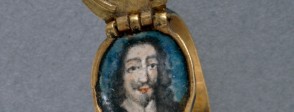The following questions and activities lead students to an exploration of the ring in detail and of who had supported the monarchy during the Interregnum and for what reasons.
First, show students the image of the ring with its lid closed from For the Classroom. Ask students what sort of person they think would own this ring and why they think that. Ask them if they think this ring would have been worn on a happy or sad occasion – highlight the colour of the ring if necessary to guide them to its connection with mourning.
Next, explain to students that this is a commemorative ring – for a special event, cause or person, but do not tell them about the portrait of Charles for now. Explain that the hinged lid can be opened to reveal something special. Given that the students now know it is a commemorative ring, ask them what they think might be hidden under the lid.
Show the image of the ring with its lid open from For the Classroom, revealing that it contains a portrait of Charles I. Explain that this ring was made shortly after his execution. Now that the students have seen the portrait of Charles, ask them again who they think would have owned this ring. Discuss the way the King is portrayed on the ring as serene and regal and not bloody or belligerent. Ask students why they think the ring has a lid. Discuss why the wearer would need to keep the portrait hidden, from whom and what risks they faced if they were seen in public wearing a piece of jewellery containing a portrait of the dead king. Go on to discuss the different factions during and in the years after the Civil War.
Explore with students the notion that not all royalists during the Interregnum were members of the nobility and landed gentry. In pairs or small groups, ask students to write up a dialogue between an elite royalist and a non-elite royalist, outlining the reasons why they support the monarchy despite their different backgrounds
Ask students if they can think of any modern examples of commemorative jewellery or objects they have seen. What sorts of symbols and motifs are used? Do these examples contain any hidden messages? Students could select an event they have studied in history and design a commemorative object, perhaps with a secret reveal.
The following questions explore the representation of Charles as a royal martyr and of Cromwell.
Compare the two prints of the execution and ascent to heaven of Charles in For the classroom. Discuss the differences of how the scene is represented and what that might tell us about how the artist wanted the viewer to interpret it. What reasons might there be for these differences?
Discuss the frontispiece for the Eikon Basilike in For the classroom. Analyse how the imagery is used to depict Charles as a religious martyr. What were the risks and benefits for the royalist cause of using this sort of imagery?
Show students The Royal Oake of Brittayne in For the classroom. Use the information in the link to analyse the imagery. Discuss how the artist uses this imagery to satirise Cromwell. Note the presence of the Eikon Basilike hanging form the tree. Use the print to explore the career of Clement Walker, author of the pamphlet and a parliamentarian who became disillusioned with Cromwell.
Look at the medals in A Bigger Picture. Encourage students to identify the symbols, motifs and inscriptions that represent the power of Charles and Cromwell: what similarities and differences do they find? Discuss the occasions for which the medals were given and the differing quality of the medals. What conclusions can they draw from this as to who the medal was intended for? Compare the imagery on the Cromwell medals with other images of Cromwell from the British Library link in For the classroom.


